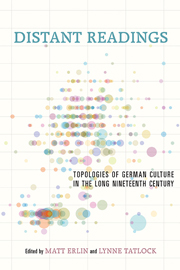Book contents
- Frontmatter
- Contents
- Acknowledgments
- Introduction: “Distant Reading” and the Historiography of Nineteenth-Century German Literature
- I Quantification
- II Circulation
- 6 The Werther Effect I: Goethe, Objecthood, and the Handling of Knowledge
- 7 Rethinking Nonfiction: Distant Reading the Nineteenth-Century Science-Literature Divide
- 8 Distant Reception: Bringing German Books to America
- 9 The One and the Many: The Old Mam'selle's Secret and the American Traffic in German Fiction (1868–1917)
- III Contextualization
- Selected Bibliography
- Contributors
- Index
7 - Rethinking Nonfiction: Distant Reading the Nineteenth-Century Science-Literature Divide
from II - Circulation
Published online by Cambridge University Press: 05 April 2014
- Frontmatter
- Contents
- Acknowledgments
- Introduction: “Distant Reading” and the Historiography of Nineteenth-Century German Literature
- I Quantification
- II Circulation
- 6 The Werther Effect I: Goethe, Objecthood, and the Handling of Knowledge
- 7 Rethinking Nonfiction: Distant Reading the Nineteenth-Century Science-Literature Divide
- 8 Distant Reception: Bringing German Books to America
- 9 The One and the Many: The Old Mam'selle's Secret and the American Traffic in German Fiction (1868–1917)
- III Contextualization
- Selected Bibliography
- Contributors
- Index
Summary
This chapter explores what computer-based techniques of distant reading and information visualization can reveal about the publishing programs of nineteenth-century mainstream weekly and monthly periodicals such as Die Gartenlaube (The Garden Bower), Westermann's Illustrirte Monatshefte (Westermann's Illustrated Monthly), Daheim (At Home), and Deutsche Rundschau (German Review), and their place in German life and letters. As scholars have stressed for some time, these periodicals represented some of post-1848 Germany's most widely read print material. Though publishing in general experienced major expansions in the latter half of the nineteenth century, mainstream periodicals rose even faster than books in terms of their circulation. Their relatively inexpensive prices and inclusion of a diverse range of topics meant that individual copies likely reached far more readers by a multiple of five or even more—a factor that has long since driven scholars to regard the periodical press as a key shaper of postrevolutionary German thought and culture. Yet as anyone who has faced the mass of articles that appeared in these periodicals during their runs can attest, illuminating that contribution by means of studying each and every text remains a daunting challenge. Already in 1907, the critic Ernst von Wolzogen observed that such an endeavor represented a “Höllenstrafe”—a punishment of eternal damnation—for which he hoped a sinner of such magnitude would never be found. Strategies of distant reading, so it seems, might present a less damning way into this material and prompt new questions with respect to how publishers changed or maintained their offerings, particularly over long time spans.
- Type
- Chapter
- Information
- Distant ReadingsTopologies of German Culture in the Long Nineteenth Century, pp. 185 - 208Publisher: Boydell & BrewerPrint publication year: 2014



